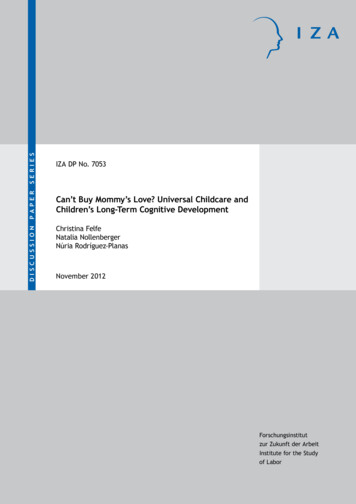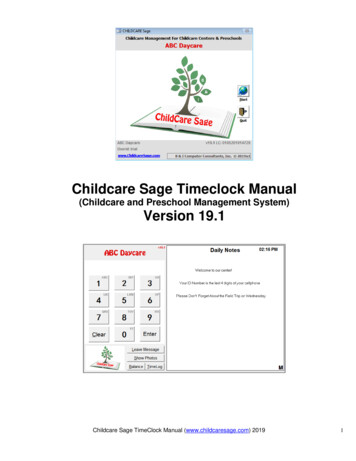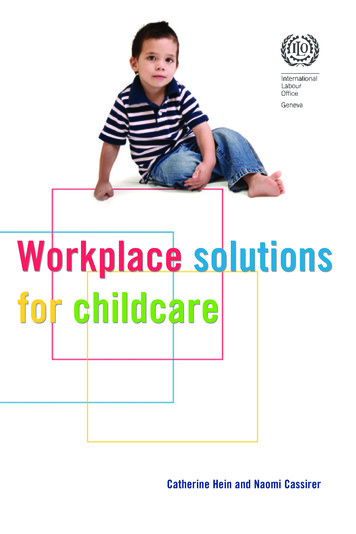
Transcription
Issue Brief Series: The Economic Benefits of EquityHigh-Quality,Affordable Childcare for All:Good for Families, Communities,and the EconomyThis is one of a series of issue briefs dedicated to helpingcommunity leaders and policymakers bolster their campaignsand strategies with the economic case for equity. The issuebriefs correspond with the 13 planks of the Marguerite CaseyFoundation’s Equal Voice National Family Platform. Additionalissue briefs can be found at olicyLink is a national research and action institute advancingeconomic and social equity by Lifting Up What Works .Marguerite Casey Foundation exists to help low-incomefamilies strengthen their voice and mobilize their communitiesin order to achieve a more just and equitable society for all.OverviewThe face of America is changing: more than half of Americansunder age five are of color, and by 2044 we will be a majoritypeople-of-color nation. But while communities of color aredriving growth and becoming a larger share of the population,inequality is on the rise and racial inequities remain wide andpersistent. Dismantling racial barriers and ensuring thateveryone can participate and reach their full potential arecritical for the nation’s prosperity. Equity—just and fairinclusion of all—is essential to growing a strong economy andbuilding vibrant and resilient communities. This issue briefdescribes how increasing access to high-quality and affordablechildcare benefits families, communities, and the economy.
Why High-Quality, Affordable Childcarefor All MattersGood childcare—from the earliest stages of life—is critical forhealthy child development and builds a strong foundation forlifelong health and economic success.1 It also gives workingparents the peace of mind they need to be productive at work.But accessing high-quality care that is affordable, convenient,and consistent can be a challenge for many families, especiallythose with low incomes.2 Many simply pay too much forreliable and quality care.3 Others struggle to find arrangementsthat work given their limited resources, fluctuating schedules,and non-nine-to-five work hours; instead they must patchtogether several arrangements and rely on relatives orneighbors to meet their childcare needs.4 With little flexibilitycoming from their employers, the lack of stable childcare placesthem at risk of losing their jobs and incomes.One in three working families in the United States struggles tomeet their basic needs of housing, transportation, andchildcare.5 Expanding access to high-quality and affordablechildcare can help these families realize their full economicpotential and foster economic growth and prosperity.Reliable Childcare Is Good for the Economy 3 Billion29%What U.S. businesses lose annuallydue to employee absenteeism as theresult of childcare breakdowns.of employed parents have reportedtardiness, absence, or reducedconcentration at work due to childcarerelated issues.23.5 Million 15.25Number of U.S. children inlow-income working families.The additional income parentsreceive for every dollar invested informal childcare.Sources: Child Care Aware, West Central Child Care Connection, the Working Poor Families ProjectHigh-Quality, Affordable Childcare for All: Good for Families, Communities, and the Economy2
The Economic Benefits of High-Quality,Affordable ChildcareAccess to childcare is vital to economic growth and the nation’sprosperity. Here are some of the ways in which reliable accessto high-quality, affordable childcare benefits the economy. Increased worker productivity. Affordable and securechildcare contributes to a more productive workforce,reduces absenteeism, and improves employee retention.Among businesses that invest in childcare options forworkers, 85 percent report improved employee recruitmentand nearly two out of three report decreased turnover. 6 Boost to businesses’ bottom line. Childcare breakdownsleading to employee absences cost businesses 3 billionannually in the United States.7 When businesses areproactive about addressing the accessibility and affordabilityof childcare, their bottom lines benefit. For every 1 thatemployers invest in back-up childcare, they can receive areturn of 3 to 4 due to increased employee productivityand reduced employee turnover.8 Higher earnings for parents in the workforce. Childcareprovides an essential infrastructure that allows parents to beemployed outside the home and to provide for their families.Every dollar invested in the formal childcare sector results in 15.25 in additional income for parents. In addition,affordable childcare increases family incomes by allowingmore parents—especially mothers—to work. If childcare costsdecreased by 10 percent, the employment rate for singlewomen would increase by 2 percent, and for married womenit would increase by 10 percent.10 Full government funding ofearly-childhood education (including childcare) wouldincrease overall maternal employment by up to 10 percent.11 Increased spending and tax revenues. Public investment inaffordable, quality childcare increases the ability of parentsto work and the amount of tax revenues collected thusresulting in lower government spending over the long term.Every dollar invested in high-quality early-childhoodeducation (including childcare) results in public savings of upto 16 in costs related to special education, grade retention,criminal justice, and welfare.12 Employment and educational support for low-incomeworking parents. The childcare industry supports the directand indirect jobs of many, and, with continued investment,could further grow employment opportunities. In one studyof student parents at community colleges, 80 percent ofrespondents reported that the availability of childcare wasvery important to their decision to pursue education, andalmost 60 percent said they would not have been able tocontinue college without childcare services.9High-Quality, Affordable Childcare for All: Good for Families, Communities, and the Economy3
Key Challenges to Ensuring High-Quality,Affordable Childcare for AllStrategies to Increase ChildcareAccess for AllSeveral policy changes must be implemented to eliminate thebarriers that limit access to high-quality and affordablechildcare for working parents.The reauthorization of the CCDF increased the availability andbreadth of federal funding to support state childcare programs.But to increase the affordability and availability of qualitychildcare for low-income working families, state and localgovernments, companies, communities, and organizationsmust take the lead in advancing creative strategies. The high cost of care. Childcare is expensive across theboard and consumes a much larger share of householdincome for low-income working families. A family of threeearning 19,760 a year can expect to spend about 50percent of their income on full-time, center-based care for aninfant.13 In 2012, the average cost for an infant in centerbased care was higher than a year’s tuition and fees at fouryear public colleges in 31 states.14 Insufficient childcare subsidies. The federal governmentprovides financial assistance for childcare for low-incomeworking parents through the Child Care Development Fund(CCDF), which was reauthorized in 2014 and expanded toimprove the quality, continuity, and availability of childcarethrough state-level funding.15 However, for various reasons,the program does not reach enough families in need, and lessthan 20 percent of eligible children receive assistance.16Often, these subsidies do not cover the full cost of highquality childcare centers. Subsidies are also tied toemployment; while the federal law does require states toprovide a minimum job-search period, loss of work may stillresult in loss of subsidies and care.17 Barriers for immigrant families. Low-wage working parentswho are immigrants report challenges to accessing subsidies,including a lack of information, eligibility concerns relating totheir immigration status, obtaining the documentationnecessary to complete the application, finding the time tocomplete the application, and language barriers.18 Low wages for childcare workers. Childcare workersgenerally earn low wages and often lack health insurance andother benefits. Full-time childcare workers earn an average of 21,490 per year,19 and approximately 95 percent of themare women.20 Develop local revenue sources to increase childcaresubsidies. Additional sources of revenue can keep childcareaffordable, provide a continuity of care even duringtemporary periods of job loss, and ensure access to highquality centers. Palm Beach County is one of nine counties inthe state of Florida where voters approved the creation of aspecial tax to fund additional services for children andfamilies, including childcare.21 The City of Seattle’s ChildCare Assistance Program also subsidizes the childcare needsof low-income residents.22 Increase availability and quality of childcare centers.Locating childcare centers at transit-oriented developmentsites where public transit and housing are co-located canmake drop-off and pickup much more convenient for parentswho live in the area. States and localities are using innovativestrategies to ensure childcare access and quality for lowincome families. They are integrating affordable childcareinto transit-oriented developments in low-incomecommunities, such as in the Fruitvale Transit Village inOakland and the Metro Center Transfer Point in KansasCity.23 They are leveraging new developments by directingtheir impact fees toward childcare facilities, as Palm Desertin California has done.24 They are setting high standards forearly childhood education. For example, the state of NewJersey mandated that all three- and four-year-old childrenliving in the state’s highest poverty districts receive highquality preschool instruction. By law, the salaries andbenefits provided to teachers in these programs must becomparable to those of regular K-12 school teachers.25High-Quality, Affordable Childcare for All: Good for Families, Communities, and the Economy4
Expand employer-provided childcare benefits for lowwage workers. Employer policies and benefits may includein-house referral services or connections to externalchildcare resource and referral agencies; childcare subsidies;on-site childcare centers; and access to after-hours care forchildren while parents work evenings, weekends, orovertime.26 ConAgra Foods, Inc., in partnership with a localHead Start program in Huntsville, Arkansas, helped to open achildcare center with extended operating hours toaccommodate parents’ late-night schedules and unexpectedovertime.27 Raise the wages and quality of childcare jobs. Researchindicates that provider training, retention, and compensationare the best indicators of childcare quality. Traininginvestments must be coupled with higher wages to promoteemployee retention and continuous professionaldevelopment. In 2013, the Service Employees InternationalUnion (SEIU) Local 509 in Massachusetts successfullyorganized to increase compensation and expand training andprofessional development opportunities for providers. Theirefforts also strengthened parents’ right to choose theirproviders and secured funding to study the need forproviding childcare during non-traditional hours to meetworking parents’ schedules. In North Carolina, the Child CareWAGE Project provides education-based salarysupplements for teachers and family childcare providers. Theprogram is structured to simultaneously improve the qualityof care, raise care-worker pay, and encourage consistencyand retention.28 Promote innovative childcare models. Center-based andhome-based providers can reduce administrative andprogram costs utilizing a shared “hub,” a centralized officethat helps with financial management, payroll processing,and collaborative purchasing of food and supplies. By poolingresources to address the “backend” services, sites are able toredeploy their staff resources to professional developmentand instruction, while also providing benefits and higherwages to their workers. Continuing education for childcareproviders can increase the overall quality of childcareservices.29 Sound Child Care Solutions in Seattle,Washington, and Early Learning Ventures in Englewood,Colorado, have implemented similar business models tosupport the professionalization of the childcare industry.30, 31Equitable Growth in ActionLeverage Public-Private Partnerships toEnsure Continuous Quality CareIn 2010, Washington State’s Department of EarlyLearning partnered with Thrive Washington to develop acomprehensive plan to provide high-quality birth-tothree childcare and early education for all children, withan explicit focus on advancing racial equity in earlyeducation. Building on the state’s school readiness plan,the birth-to-three plan aims to strengthen connectionsamong parents, caregivers, health care professionals, andother service providers. By investing in professionaldevelopment for childcare workers, increasing subsidiesto make quality care accessible for all families, andintegrating health and wellness into developmentalgoals, Washington State is taking steps to build a moreeffective and equitable childcare system. In 2015, anadditional investment of 94.5 million brought thestate’s total early-learning budget to 158 million,expanding services to 48,000 children in Washington andguaranteeing a full 12 months of benefits for the 31,000children enrolled in Working Connections Child Care,the state’s subsidized childcare program for low-incomefamilies.Sources: Washington State Birth to 3 Plan, Thrive byFive Washington, Washington State Department of EarlyLearning BlogHigh-Quality, Affordable Childcare for All: Good for Families, Communities, and the Economy5
Learn More California Child Care Resource & Referral Network Promotingaffordable, quality childcare and providing support to anetwork of resource and referral programs in California.AcknowledgmentsMany thanks to Linda Asato of the California Child CareResource & Referral Network for her thoughtful review andfeedback on this brief. Zero to Three Research-based policy center focusing on thedevelopmental needs of infants and toddlers. National Domestic Workers Alliance Coalition working tosecure state, national, and international labor protections fordomestic workers. Child Care Aware Childcare information hub featuringresearch and resources for parents and providers. National Association for the Education of Young ChildrenConnecting research, policy, and practice to promote earlylearning for children from birth to age eight.High-Quality, Affordable Childcare for All: Good for Families, Communities, and the Economy6
Notes12Frances Campbell, Gabriella Conti, James J. Heckman, SeongHyeok Moon, Rodrigo Pinto, Elizabeth Pungello, and Yi Pan, “EarlyChildhood Investments Substantially Boost Adult Health,” Science28 (2014): 1478-1485, ay Chuadry, Juan Manuel Pedroza, Heather Sandstrom, AnnaDanziger, Michel Grosz, Molly Scott, and Sarah Ting, Child CareChoices of Low-Income Working Families (Washington DC: UrbanInstitute, 2011), port.34The California Child Care Resource and Referral Network, “ChildCare in Californian,” Infographic, ct/specialsummaryrev2011 02 2.pdf.13 Child Care Aware, Parents and the High Cost of Child Care 2013(Arlington, VA: Child Care Aware of America, 2013), http://edsource.org/wp-content/uploads/cost ofcare 2013 103113 0.pdf.Gregory Acs and Austin Nichols, Low-Income Workers and TheirEmployers: Characteristics and Challenges (Washington DC: TheUrban Institute, 2007), http://www.urban.org/research/15 “CCDF Reauthorization Frequently Asked Questions,” Office ofChild Care, reauthorization-faq (accessed July 22, 2015).Brandon Roberts, Deborah Povich, and Mark Mather, Low-IncomeWorking Families: The Growing Economic Gap (Washington, DC: TheWorking Poor Families Project 2012-2013), ads/2013/01/Winter-2012 2013-WPFP-Data-Brief.pdf.Early Care and Learning Council, “Why Should Employers Care?Relationship Between Productivity and Working Parents,” factsheet, 4/07/Why-Should-Employers-Care-ECLC.pdf.712 Lawrence J. Schweinhart, Jeanne Montie, Zongping Xiang, W.Steven Barnett, Clive R. Belfield, and Milagros Nores, LifetimeEffects: The High Scope/ Perry Preschool Study Through Age 40(Ypsilanti, MI: High/Scope Press, 2005), http://www.highscope.14 Ibid.Child Care for Low-Income Families: Patterns of Child Care UseAmong Low-Income Families (Washington, DC: U.S. Department ofHealth and Human Services, 2007), tterns cc workers-and-their-employers/view/full report; Jean I. Layzer and Nancy Burstein, National Study of511 David M. Blau, “The Child Care Problem: An Economic Analysis,”Journal of Policy Analysis and Management 22 (2003): 143-162,D. E. Friedman, “Child Care For Employees’ Kids,” Harvard BusinessReview, 64 (1986): 28-32., cited in Karen Shellenback, “Child Careand Parent Productivity: Making the Business Case” (Ithaca, NY:Cornell University, 2004), nts/000/000/074/original/154-21008542.pdf.16 Office of the Assistant Secretary for Planning and Evaluation,Estimates of Child Care Eligibility and Receipt for Fiscal Year 2009(Washington DC: Office of the Assistant Secretary for Planning andEvaluation, 2012), ib.pdf.17 “Does the Law Specify a Length of Time For Re-determining aFamily’s Eligibility?” The Office of Child Care (OCC) reauthorizationfaq#12%20Month%20Eligibility (accessed July 22, 2015).18 The Ms. Foundation for Women, Listening to Workers: Child CareChallenges in Low-Wage Jobs (New York, NY: The Ms. Foundation forWomen, 2014), Wage%20Jobs.pdf.19 Child Care Aware of America, Parents and the High Cost of ChildCare 2013.20 “The Child Care Workforce,” The National Association of Child CareResource and Referral Agencies, Factsheet, http://www.naccrra.org/sites/default/files/default site pages/2011/the childcare workforce march2011.pdf.8Jill Elswick, More Employers Offer Backup Child Care (Arlington, VA:Employee Benefit News, June 23, 2003)21 “Creating a CSC,” Children’s Services Council Palm Beach County,http://www.cscpbc.org/create-a-csc (accessed July 22, 2015).9Carol R. Keyes and Pamla Boulten, “Campus Children’s Centers:Support for Children and Families,” Children Today 23 (1995): 1821.22 “Child Care Assistance Program,” Human Services Department ofCity of Seattle, school/child-care-assistance-program (accessed July22, 2015).10 Jean Kimmel, “Child Care, Female Employment, and EconomicGrowth,” Community Development 37 (2006): 71-85, nts/000/000/35 4aa92583.23 “Building Child Care Into New Developments: A Guide ForCreating Child Care Facilities In Transit-Oriented Developments,”Local Investment in Child Care, 20080624linccdevBRweb.pdf.High-Quality, Affordable Childcare for All: Good for Families, Communities, and the Economy7
24 Bill Byron, “City OKs Fee to Fund Child Care,” The Desert Sun,October 14, 2005, http://www.impactfees.com/pdfs f.25 “New Jersey Abbott Program,” CLASP, ates/0230.pdf (accessed July21, 2015).26 “Developing Child Friendly Policies and Procedures,” EarlyChildhood Development Toolkit for Employers, d-friendly-policies.html (accessed July 20, 2015).27 Pamela Winston, Meeting Responsibilities at Work and Home: Publicand Private Supports (Washington DC: Urban Institute, 2007),http://www.urban.org/UploadedPDF/411537 meetingresponsibilities.pdf.28 “Child Care WAGE Project Statewide Final Report Fiscal Year2012,” Child Care Services Association, http://www.childcareservices.org/ downloads/WAGES StatewideFY12Full.pdf (accessed July 15, 2015).29 “Our Community,” Santa Cruz Community Credit Union, anta-cruzcommunity-ventures.html (accessed July 22, 2015).30 “Home,” Sound Child Care Solutions, http://soundchildcare.org/about/ (accessed July 22, 2015).31 “Home,” Early Learning Ventures Stronger Together, http://earlylearningventures.org/ (accessed July 22, 2015).High-Quality, Affordable Childcare for All: Good for Families, Communities, and the Economy8
Lifting Up What Works Headquarters1438 Webster StreetSuite 303Oakland, CA 94612t 510 663-2333f 510 663-9684Communications55 West 39th Street11th FloorNew York, NY 10018t 212 629-9570Washington, DC Office1200 18th Street, NWSuite 200Washington, DC 20036Los Angeles Office1000 North Alameda Street2nd FloorLos Angeles, CA 90012www.policylink.orgFacebook: /PolicyLinkTwitter: @policylink1425 4th Ave, Suite 900Seattle, WA 98101t 206 691-3134f 206 286-2725 2016 PolicyLink. All rights reserved.
Care Assistance Program also subsidizes the childcare needs of low-income residents.22 Increase availability and quality of childcare centers. Locating childcare centers at transit-oriented development sites where public transit and housing are co-located can make drop-off and pickup much more convenient for parents who live in the area.










